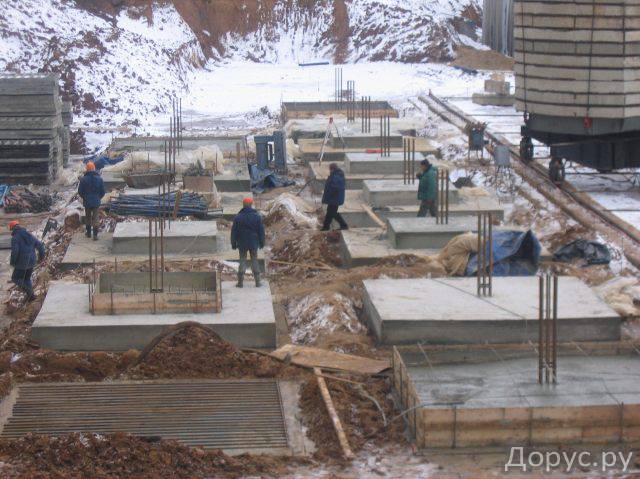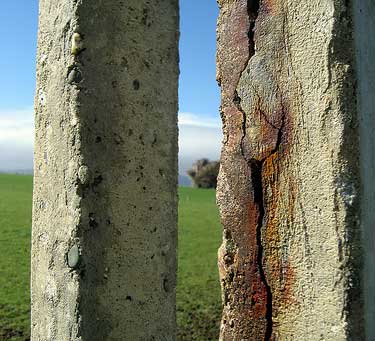
- •Introduction
- •History
- •Classification of Concretes
- •Materials for Heavy Concrete
- •Properties of Concrete Mixes and Concretes
- •Preparation and Transportation of Concrete Mixes
- •Fig. 3. Continuous concrete mixer
- •Placing Concrete Mixes, Curing Concrete and Quality Control
- •Internal vibrators are used for compacting concrete mixes in massive constructions of great depth (thickness). Used as internal vibrators are:
- •In cold seasons, concrete should be protected against excessive cooling, which slows down hardening, and the more so against freezing.
- •Specific Properties of Concrete
- •Environment and health
- •Building with concrete
- •Concrete as environmentally friendly choice
In cold seasons, concrete should be protected against excessive cooling, which slows down hardening, and the more so against freezing.
Constructions may be loaded only after control specimens of concrete have been tested.
Tests of concrete quality. Properly organized checks of the quality of concrete at all stages of building concrete structures are one of the major conditions for obtaining strong and durable concrete and reducing the cost of the structures. Checks involve testing and choosing ingredient materials, proportioning, mixing, placing, compacting and curing and, finally, strength determination of concrete by testing hardened specimens.
Strength and quality of concrete in a construction may be roughly evaluated by non-destructive testing with the aid of acoustic devices. Their work is based on the velocity of propagation of an ultrasonic pulse or impact wave in a material which depends on the latter's density and strength. The strength of concrete in a construction may be determined by non-destructive mechanical techniques, e.g., by means of a device whose work is based on the strength characteristic, which corresponds to the depth of an indentation made in concrete by a ball, or to the height of rebound of a pendulum.
Specific Properties of Concrete
Density and impermeability of concrete to liquids and gases. High-density concrete is obtained by a rational choice of aggregate (of minimum voidage), use of concrete mixes of low water-to-cement ratio, intensive compaction, introduction of plasticizing and hydrophobic surfactant admixtures.
It should be borne in mind, however, that there is no such thing as absolutely dense concrete. Its porosity is due to the evaporation of water which has not interacted chemically with cement as it hardens, to incomplete removal of air bubbles during compaction of the concrete mix, etc. Therefore, concrete is a material permeable to gases. To make concrete constructions gas-impermeable, their interior surfaces are coated with gas-impermeable films, such as plastic.
An adequately thick construction from dense concrete with a fine pore structure is practically watertight. Water impermeability of concrete is characterized by the highest pressure of water which concrete is capable of resisting without letting water through. According to its impermeability to water, concretes fall into four grades: B2, B4, B6 and B8 that correspond to pressures of 2, 4, 3 and 8 kg/cm2, respectively.
Thinner constructions can be made perfectly watertight by using hydrophobic cement. Another method consists in applying a coat of waterproof plaster by pneumatic techniques (guniting).
A
 dense concrete can be made impermeable not only to water, but also to
viscous oil products, such as fuel oil and heavy oil. Light medium
oil fractions, e.g., gasoline and kerosene, penetrate concrete at a
greater ease than water. In order to protect concrete and reinforced
concrete installations intended for storage of heavy oil products,
their surfaces are coated with water glass; to protect them against
penetration by light and fluid oil products (gasoline, kerosene,
etc.), their surfaces are covered by special gasoline-proof
membranes, special coats (plastic films) or by building the
installations of expanding concrete which is impervious to the above
fluids.
dense concrete can be made impermeable not only to water, but also to
viscous oil products, such as fuel oil and heavy oil. Light medium
oil fractions, e.g., gasoline and kerosene, penetrate concrete at a
greater ease than water. In order to protect concrete and reinforced
concrete installations intended for storage of heavy oil products,
their surfaces are coated with water glass; to protect them against
penetration by light and fluid oil products (gasoline, kerosene,
etc.), their surfaces are covered by special gasoline-proof
membranes, special coats (plastic films) or by building the
installations of expanding concrete which is impervious to the above
fluids.
Frost resistance is one of the major requirements upon a concrete for hydraulic engineering structures, road surfaces, bridge piers, etc. Frost resistance of concrete is characterized by the maximum number of freezing-and-thawing cycles that 28-day specimens are capable of withstanding without losing more than 25% of their .strength and more than 5% of their weight.
The grade of concrete is chosen by its frost resistance according to the climatic conditions (i.e., the number of fluctuations of the level of water that washes the concrete or the number of freezing-and-thawing cycles during the winter season).
Generally, frost-resistant concretes are of high density. Production of such concretes has been discussed previously. Aggregates play an important part in the frost resistance of concrete. The grade of aggregate in terms of its frost resistance should not be lower than that of concrete.
Shrinkage and expansion of concrete. In the process of hardening, concretes undergo volumetric changes. Hardening of concrete in the air (with the exception of concrete from non-shrinking and expanding cements) is accompanied by a decrease in its volume, i.e., by shrinkage. When concrete hardens in water, its volume increases during the initial period of hardening; under air-setting conditions, concretes shrink. Concretes from fluid mixes (with high cement consumption and high water-to-cement ratio) shrink considerably. Shrinkage is maximum during the initial period of hardening, its value being 60 to 70% of the shrinkage after a month of hardening. This is due to the fact that cement paste loses water at a high rate owing to the evaporation and absorption of water by cement as it hydrates. Dehydrated particles draw close together, and the cement stone shrinks.
Volumetric changes in concrete during the initial period of hardening are due to expansion caused by the heat released during exothermic reactions between cement and water, which may raise the temperature inside heavy concrete constructions up to 50°C. Volumetric changes of concrete may cause considerable deformation and even cracking of constructions. To prevent such things, special expansion joints are provided in massive concrete constructions, and use is made of cements with a low heat release.
T
 he
shrinkage of portland cement concrete depends on the mineralogical
composition and fineness of cement, the shrinkage increasing with
fineness.
he
shrinkage of portland cement concrete depends on the mineralogical
composition and fineness of cement, the shrinkage increasing with
fineness.
Aggressive media and means of protection. Practice has shown that water-supply and sewer concrete constructions may fail under physical and chemical action of liquids and gases. Concrete is corroded mainly through disintegration of the cement stone (while the aggregate may have been chosen adequately resistant). Corrosion of concrete is due to the penetration of an aggressive substance into the body of concrete; the corrosion is particularly intensive when such substances continuously filtrate through cracks and pores in concrete. Therefore, the principal means of protection against corrosion is to make concrete as dense as possible and to design correctly the constructional components, so as to ensure uniform deformation of concrete in the process of hardening (free from cracks).
Corrosion of concrete may be prevented by using cements containing substances that chemically bind the lime that is given off in the hydrolisis of tricalcium silicate and which carry active mineral admixtures and small amounts of tricalcium aluminate. Classed with this type of cements are portland cements with hydraulic admixtures, slag portland cement, aluminous cement, sulphate-resisting cement. In order to eliminate pores in the surface layers of concrete, it is a current practice to impregnate them with cement mortar and to silicate and fluate them. Concrete can be protected against corrodents by surface coats, (facing with solid impermeable ceramic tiles or stones laid with the use of acid-resistant cement); coating with waterproof shells from tamped fat clay (loam, etc.); facing with waterproof bituminous materials, etc.
High-temperature resistance. Concrete is a fire-resistant material as it is capable of withstanding the action of high temperatures during fires. Fire resistance of concrete allows to use it for building chimney stacks of industrial furnaces and their foundations; in recent years, concretes of special compositions are being used on ever increasing scale for lining thermal apparatus operating at temperatures of 1000°C and higher.
Fire resistance of concrete depends not only on the kind of cement, but also on the nature of aggregates. If the aggregates are composed of crystalline quartz rock, concrete may crack at about 600°C because of a considerable increase in the volume of quartz.
Special heat-resisting concrete is used in constructions exposed to the action of high temperatures (above 250°C) for long periods of time.
